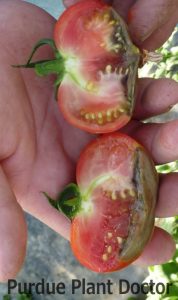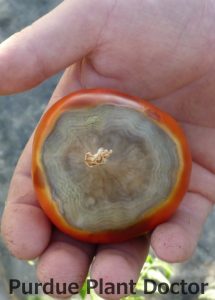
Blossom-end rot inside tomato
Photo credit: Purdue Tomato Doctor App
Q. I was wondering if you had any solutions for tomato rot. I throw my grass clippings on the soil to keep the weeds out. Does that have anything to do with it? – RM, Tinley Park, Illinois.
A. Blossom-end rot is a common problem of tomatoes; it’s named for the black, leathery scar that develops on the blossom end of the fruit opposite the point of stem attachment.
The black scar tissue is caused by a deficiency of calcium in the developing fruit and is most commonly associated with extreme fluctuations in soil moisture. The scar is usually firm and leathery, although secondary rot organisms may enter through the damaged tissue, causing a soft rot to develop.

Blossom-end rot on tomato
Photo credit: Purdue Tomato Doctor App
Tomatoes are the crop most frequently affected by blossom-end rot, but peppers, summer squash and other cucurbit plants can also be afflicted.
There is no spray that will control blossom-end rot, except perhaps from the irrigation hose. Some folks recommend spraying the plants with calcium, but by the time you see the scar on the fruit, it is too late. Most Midwest soils have plenty of calcium, although some sandy soils may be deficient.
Although the fruits that have already developed the scar cannot be helped, the new developing fruits can be. Watering during dry spells and mulching to conserve soil moisture will help reduce fluctuations in soil moisture and thus encourage steady growth and calcium supply in the fruits.
For more information on diagnosing tomato problems, check out the Purdue Tomato Doctor app.